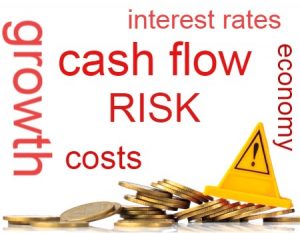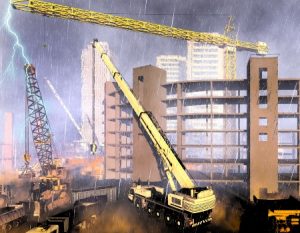
1. Safety/ Occupational Risks
Safety risks include injuries, fatalities or illnesses that come about because of employee behaviour (e.g. negligence), poor procedures/ methods being deployed, equipment or technology failure, the weather or third party issues. The nature of the construction industry means that these type of risks are particularly commonplace and, along with the potential for serious impacts on employees’ health and wellbeing, they can also be the cause of major disruption to how a project progresses.
 2. Financial Risks
2. Financial Risks
For many construction companies, doing business is a long-term game, meaning they’re handling projects that can span years. That makes them susceptible to all kinds of financial risks – for instance, unmanaged growth, running out of cash flow, rising interest rates, increasing cost of materials, a plummeting economy or other factors that might result in a loss of funds and abandoned projects.
3. Project Risks
Project risks include things like mismanaged funds, poor project management, inefficient processes, inadequate company policies (or ineffective application of policies), mistakes around the calculation of time/resources required and lack of proper operational guidelines.
 4. Natural/ Environmental Risks
4. Natural/ Environmental Risks
Natural or environmental phenomena – like floods, earthquakes and other extreme weather conditions – can present huge risks for construction sites, causing damage, preventing access and derailing programmes of work.
5. Legal/ Contractual Risks
Most construction projects involve one set of companies working for another set (i.e. subcontractors working for main contractors). This kind of arrangement starts with signing a legally binding contract which, among other things, specifies the length of the project and how much the supplier will get paid. Legal risks can therefore arise from any breach of the contract terms – for instance, where a client fails to make payment as scheduled or where the job isn’t completed on time and so penalties are incurred.
Managing the risks
The good news is that, although construction projects and tasks are varied and often complex, the industry is very familiar with carrying out regular risk assessments and there are response strategies for dealing with risks which can be simplified into four categories:
- Avoid: If your company or team is ill-equipped to deal with a particular risk, it might be best to avoid it completely. For example, you could reject projects that are located in areas prone to earthquakes or floods or you might avoid dealing with a contractor who has previously been late with payments.
- Transfer: There are several ways to transfer a risk (i.e. hand it over to someone else). Taking out specific insurance is a common method. Another would be where you subcontract work to another supplier or professional who has more expertise than your company to manage the task and its associated risks.
- Mitigate: Mitigating risks basically means taking action that reduces the potential impact – using proper safety equipment, ensuring workers undergo all necessary training and keeping everyone informed about risks via good communication are all good examples.
- Accept: Some risks are simply beyond your control and so there is little you can do other than accept them and try to be as prepared as possible. Bad weather or natural disasters, for example can cause disruption and delays but keeping a watch on the forecasts can at least help you make some preparations for whatever is coming.
Plan ahead
This brings us to one of the key points in risk management. It is absolutely vital that you plan ahead and put processes in place to deal with risks before they have any chance of becoming a big problem.
Develop a strategy for each project and each task, take out appropriate insurance, create safety programmes, carry out essential training, build in risk review processes, prepare a ‘plan B’ for any unavoidable hazards and, because risks affect people at every level in construction, get everyone involved.
In construction, risk management is most effective when everyone is on the same page. As we begin the process of working on sites again during the current coronavirus crisis, following good risk management strategies is more important than ever. Just remember there’s more than one risk out there!
14.05.2020
Main image source: Shutterstock
WilliamPotter/Shutterstock.com; Aggie11/Shutterstock.com; DariushM/Shutterstock.com








